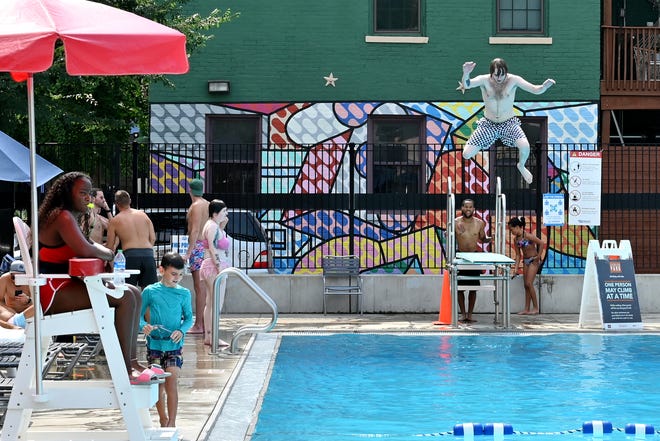

School’s out but some authorities say there are still important skills for youngsters to learn during summer vacation.
Such as how to swim.
An estimated 1,000 children drown every year in the United States, Dawne Gardner, an injury prevention specialist at Cincinnati Children’s Hospital Medical Center, said.
Another 7,000 end up in emergency rooms because of a near-drowning.
The hospital’s trauma registry data shows there were 148 drowning and near-drowning incidents in Greater Cincinnati from January 2016 to March 2022, Gardner said.
The total includes 14 in 2021 and four as of March this year.
The fact that bodies of water can be deadly – and not just to children – was brought home over the Memorial Day weekend.
A 31-year-old Pennsylvania man died while jet skiing Sunday at Caesar Creek State Park in Waynesville, although his cause of death has not been released.
A 16-year-old Florence boy is believed to have drowned Monday at East Fork State Park in Clermont County.
Lifeguard jobs going unfilled: Cincinnati to offer $750 bonus so more pools can open
“Swim lessons teach children safe habits in and around water while providing instructions on becoming stronger, safer swimmers,” Gardner said.
“Swim lessons also are a fun way to help children stay active while building confidence and respect for water.”
The COVID pandemic has intensified the need for swimming lessons
“Because of the pandemic, many children were not in regular swim lessons for nearly two years, putting them at increased risk,” said Richard Simtob. He is the co-owner of a new Goldfish Swim School for children set to open next year on Pine Road in Kenwood.
Simtob, a West Bloomfield, Michigan, businessman, also co-owns other franchise Goldfish Swim Schools for kids aged 4 months to 12 years in Anderson and West Chester townships.
“As we prepare for beach and pool season, it is critical that all kids have the opportunity to practice the skills that will keep them safer in and around water,” Simtob said.
While recreation centers and YMCAs remain familiar places to learn how to swim, Simtob’s schools represent just a few of the private venues popping up in Cincinnati and Northern Kentucky.
A breakdown of drowning statistics for youths suggests all are needed.
- Youth drownings dropped 38% between 1999 and 2019, the National Vital Statistics System says.
- But it also says drowning remains the leading cause of accidental injury deaths for children 1- to 4-years-old and the second (behind traffic wrecks) for children newborn to age 17.
- The Centers for Disease Control and Prevention says drowning deaths among 5- to 9-year-olds dropped from 134 in 2019 to 117 in 2020 and from 106 in 2019 to 91 in 2020 among 10- to 14-year-olds.
- On the other hand, it says drowning deaths among 1- to 4-year-olds increased from 382 in 2019 to 425 in 2020.

Shortages of lifeguards and pool chemicals mean less access to lessons
Some children who take swimming lessons can’t practice their skills because they don’t have access to pools.
One reason is fewer pools are open. A national and local shortage of lifeguards means it's getting harder for pools to find youths ready to scan the water with a whistle around their neck.
Kenwood:Private swim school proposed
Some reasons for the shortage include the fear of catching COVID-19, an increase in family vacations paused by the pandemic and the availability of better-paying jobs.
Cincinnati, for example, only has enough lifeguards to open eight of its 23 public pools.
These public Cincinnati pools will open by June 6:
- Dunham Otto Armleder Pool in Westwood.
- Hirsch Otto Armleder Pool in Avondale.
- Dempsey Pool in East Price Hill.
- Evanston Pool.
- Lincoln Pool in the West End.
- McKie Pool in Northside.
- Oakley Pool.
- Pleasant Ridge Pool.
City council agreed in May that the Cincinnati Recreation Commission could offer lifeguards bonuses of $750, or more if that did not bring in the 127 more lifeguards it needs to reach its goal of 214.
Since then, only four more lifeguards signed up. Now, the recreation commission is offering bonuses up to $2,000 and hopes training lessons it is sponsoring will attract more lifeguards.
If it gets enough lifeguards, the commission will open additional pools in the city’s far east and far west neighborhoods.
Yet another wrinkle in this year’s swim season is that supply chain problems stemming from COVID-19-related labor shortages and transportation delays have contributed to a national shortage of chlorine.
'Unwavering, universal demand for swim lessons'
Pandemic or no, “There’s an unwavering, universal demand for swim lessons as they have been proven to significantly decrease the risk of drownings by 88%,” Simtob said.
“It’s our hope that with more learn-to-swim providers, we’ll be able to combat the staggering statistics and provide more children this lifesaving skill.”
Source link







